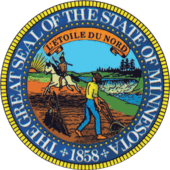Stephen Miller
| Stephen Miller | |
|---|---|
|
Stephen Miller | |
| 4th Governor of Minnesota | |
|
In office January 11, 1864 – January 8, 1866 | |
| Lieutenant | Charles D. Sherwood |
| Preceded by | Henry Adoniram Swift |
| Succeeded by | William Rainey Marshall |
| Member of the Minnesota House of Representatives from District 38 | |
|
In office January 7, 1873 - January 5, 1874 | |
| Personal details | |
| Born |
January 7, 1816 Carroll Township, Perry County, Pennsylvania |
| Died |
August 18, 1881 (aged 65) Worthington, Minnesota |
| Political party | Republican |
| Spouse(s) | Margaret Funk |
| Profession | businessperson, real estate agent, attorney, soldier |
Stephen Miller (January 7, 1816 – August 18, 1881) was an American Republican politician. He was the first Civil War veteran to serve as Minnesota Governor. He was the fourth Governor of Minnesota.
Early years and business entrepreneur
Born in Carroll Township, Pennsylvania, Stephen Miller established a series of successful businesses.[1] Frail health prompted the Pennsylvania Dutch entrepreneur to leave home at age 42 and follow his friend Alexander Ramsey to Minnesota, where the climate reportedly was more congenial. Miller established a mercantile business in St. Cloud and, within two years, had risen to prominence in the state Republican Party.[2]
Civil War soldier and leader

During the Civil War, this middle-aged soldier with no previous military experience advanced rapidly from the rank of private to colonel in the 1st Minnesota Infantry. In 1862 Miller returned from the South and replaced Brig. Gen. Henry Hastings Sibley as commander of Mankato's Camp Lincoln. There, 303 Dakota men, convicted of participating in the Dakota War of 1862, awaited their fate. Four months later, Miller supervised, by order of President Lincoln, the mass execution of 38 Dakotas condemned for their part in the war.[1][2]
Governor of Minnesota
His military career and Alexander Ramsey's support assured Miller of a gubernatorial victory in 1863. He was the 4th Governor of Minnesota, serving from January 11, 1864, to January 8, 1866. He was the first of several Civil War veterans to serve as Governor of Minnesota. Although lacking a college degree himself, he valued higher education and advocated generous appropriations to the University of Minnesota and to state normal schools, one of which evolved into St. Cloud State University. In his final address to the legislature, he strongly but unsuccessfully urged adoption of a black suffrage amendment to the state constitution.[2]
Later years and term as state representative
Miller chose not to run for re-election and was unemployed until 1871, when he became a railroad-company field agent in Windom. He served as a state representative from January 7, 1873, to January 5, 1874, representing then-District 38, which included all or portions of Cottonwood, Jackson, Murray, Nobles, Pipestone and Rock counties in the southwestern part of the state. During his term, he was chair of the House's Public Lands Committee.[3] In 1876, he was a representative to the Electoral College. The one-time war hero and popular governor died alone, an impoverished widower, in Worthington in 1881.[2]
References
External links
- Biographical information and his gubernatorial records are available for research use at the Minnesota Historical Society.
| Political offices | ||
|---|---|---|
| Preceded by Henry Adoniram Swift |
Governor of Minnesota 1864–1866 |
Succeeded by William Rainey Marshall |

